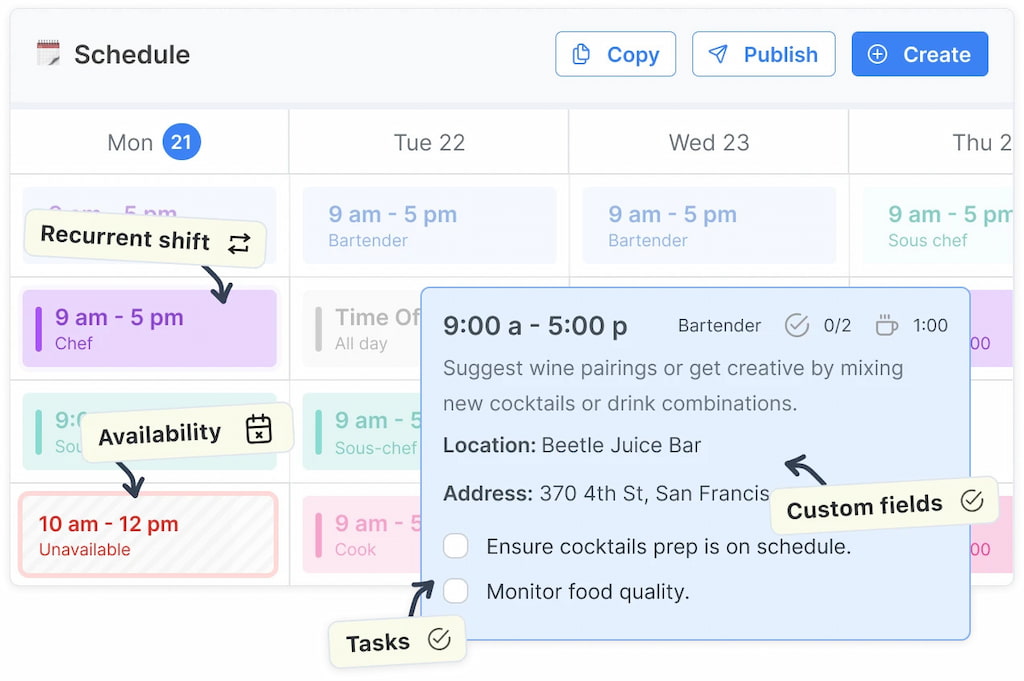Imagine it’s holiday season and five key team members submit vacation at once. You scramble to approve or delegate. Meanwhile, no one updated the spreadsheet—or worse, the spreadsheet doesn’t exist. Leave approvals fall through the cracks, staffing gaps widen, and paid time off gets messed up. In this article, you’ll learn how modern leave management systems fix that by automating workflows, enforcing policy logic, tracking accruals, and integrating with scheduling and time-tracking. We’ll cover what these systems are, why they matter in 2025, the features to look for (for example, time off requests), how workflow integration with tools like Shifts by Everhour elevates your process, plus best practices, comparisons, FAQs and a clear framework to select the right system.
🌿 What Is a Leave Management System?
A leave management system is software designed to automate and manage employee time-off requests (vacation, sick, parental leave, comp time, etc.), track accruals and balances, manage approval workflows, ensure compliance with laws and policies, and provide visibility to HR, managers, and staff alike.
It replaces spreadsheets and long email chains with a transparent, organized workflow. Its value continues to grow in 2025 because:
- 🌍 Remote and hybrid work: Make leave patterns less predictable
- ⚖️ Compliance complexity: Global labor laws like FMLA demand accuracy
- 📱 Workforce expectations: Employees expect real-time visibility and self-service tools
- 💼 Operational impact: Burnout, misuse, and staffing gaps have higher costs
As PeopleManagingPeople notes, organizations relying on manual methods face errors, delays, and compliance risks.
🌿 Key Features & Use Cases of Effective Leave Management Systems
Modern leave management platforms go far beyond basic time-off tracking — they turn leave coordination into a smooth, data-driven process that benefits both HR and employees.
🧭 1. Clear self-service request flow
Employees submit requests directly through a portal or app, view balances instantly, and choose dates without email chains.
✅ Example: A marketer spots they’re three days short of annual leave — so they opt for remote days instead.
⚙️ 2. Automated accruals & balances
The system calculates entitlements (e.g., “1.67 days/month”) and manages carryovers automatically.
✅ Example: A part-time hire mid-year gets prorated leave without HR intervention.
📬 3. Approval workflows & delegation
Requests route automatically to the right manager and escalate if someone’s away.
✅ Example: A sales lead on vacation? The request moves to the regional head seamlessly.
📅 4. Calendar & staffing visibility
Managers see at a glance who’s off and when — avoiding coverage gaps.
✅ Example: A warehouse manager spots five operators on leave next week and denies a sixth to keep workflow steady.
🛡️ 5. Policy & compliance engines
Systems enforce company rules and local regulations automatically — from blackout dates to carry-over caps.
✅ Example: In a U.S. state with new parental-leave laws, the platform flags eligibility updates instantly.
📊 6. Reporting & analytics
Interactive dashboards reveal leave patterns, absentee trends, and cost breakdowns.
✅ Example: HR discovers Customer Service has 25% more unplanned leave and targets wellness programs.
🔗 7. Integration with scheduling, time tracking & payroll
When leave management connects with scheduling and payroll tools, approvals update shifts and trigger replacements automatically.
✅ Example: Mary books PTO, and her shift instantly moves to the open swap board.
Comparison Table: Top Leave Management Systems
| Tool | Key Features | Pricing/Plan | Ideal For |
| Shifts by Everhour | Leave integration with scheduling; open-shift publishing; time-tracking sync; mobile approval; scheduled vs actual reports | Free & paid plans | Organisations that need leave + schedule + time tracking in one unified system |
| BambooHR | PTO tracking; accrual engine; approval workflows; reporting dashboards | Paid plans (starts ~US$-) | HR teams wanting an all-in-one HRMS with strong leave module |
| Timetastic | Dedicated leave tracker; simple UI; team calendar view; usage insights | Paid plans (per user) | Small businesses needing straightforward leave tracking |
| Calamari | Multi-location leave policies; mobile app; Slack/Teams integration; global holiday calendars | Free trial + paid plans | Distributed teams and global workforces |
| AbsenceSoft | Automates 200+ leave laws; workflows for accommodation; compliance engine; reporting | Enterprise licensing | Large enterprises with complex leave, especially FMLA/ADA heavy |
| DATABASICS | PTO & leave management; timesheet integration; accrual management; payroll sync | Paid plans | Mid-market/enterprise organisations needing integrated absence and time systems |
| LeaveManager (JJ Keller) | Cloud leave tracking; FMLA & ADA support; audit history; cloud-based forms | Paid plans | Organisations prioritising regulatory compliance in the U.S. |
| Vacation Tracker | Slack/Teams integration; simple user interface; team calendar; usage tracking | Paid plans (per user) | Teams wanting lightweight leave tracking inside collaboration tools |
Tool highlights
- Shifts by Everhour stands out for combining leave, scheduling and time tracking—not just leave in isolation.
- BambooHR is strong for teams that want a full HRMS with leave built-in.
- Timetastic works well for small businesses seeking simplicity.
- Calamari excels for global teams with multi-location and multi-holiday demands.
- AbsenceSoft is designed for enterprise compliance with complex leave/ADA laws.
- DATABASICS links absence management with timesheet and payroll systems.
- LeaveManager is ideal for U.S. organisations focusing on FMLA and regulatory compliance.
- Vacation Tracker fits well inside chat tools like Slack for distributed or remote-first teams.
🟢 How Shifts by Everhour Complements Leave Management
Leave management alone isn’t enough — you need integration with scheduling and time tracking to maintain coverage and accuracy. Shifts by Everhour bridges that gap seamlessly.
- 📌 Automatic shift updates: When leave is approved, Shifts marks shifts as “vacant,” publishes open slots, notifies staff, and prevents coverage gaps.

- ⏱️ Accurate payroll: Logged hours (via Everhour) are compared with scheduled hours, factoring in approved leave to avoid ghost or missed hours.
- 👀 Unified visibility: HR sees leave data, operations sees availability, managers see scheduled vs. actual — keeping everyone informed.
- ⚖️ Compliance-safe scheduling: Labor-law guardrails (overtime, rest breaks) are enforced automatically when leave interacts with schedules.
In short: leave + schedules + time capture = fewer surprises and smoother staffing operations.
📝 Best Practices for Implementing Leave Management Systems
- 📄 Document your time-off policy: Include accruals, carry-over rules, blackout periods, and roles that cannot be absent simultaneously.
- 📅 Use a centralized leave calendar: Make absences visible across teams—no hidden gaps.
- ⏳ Set SLAs for approvals: Ensure managers respond within a defined time (e.g., 48 hours) to keep requests moving.
- 👤 Train employees in self-service: Enable request submission, balance view, and calendar lookup.
- 🔄 Prepare coverage plans: Backfill key roles to prevent workflow disruptions when staff are out.
- 📊 Monitor leave trends: Track frequent absences, high-request patterns, and understaffed periods.
- 🔗 Integrate early: Connect with scheduling or time-tracking systems instead of relying on spreadsheets.
- ✅ Audit annually: Reconcile balances, check accruals, and account for unused leave liabilities.
- ⚖️ Ensure compliance: For global teams, adhere to local leave and absence laws.
❓ FAQ – Leave Management Systems
What is the difference between leave management and time-off tracking?
Leave management systems not only track requests or balances, they also enforce policy logic, integrate with schedules/time tracking, and provide compliance workflows. Time-off tracking may only log days off.
How far in advance should employees request leave?
It depends on your organisation, but many organisations set minimum notice of 2-4 weeks for planned leave. The key is publishing that policy and automating enforcement.
Does leave management software help with compliance?
Yes—tools like AbsenceSoft and LeaveManager automate eligibility checks (e.g., FMLA), flag potential violations, and maintain audit histories.
Can leave management integrate with scheduling?
Absolutely. For example, Shifts by Everhour integrates leave approvals directly into scheduling workflows—so when someone is approved for leave, their shift is flagged or replaced automatically.
How do I reduce “leave abuse” or over-request patterns?
Use analytics to spot frequent leave takers, analyse patterns (day before payday, end of quarter), and enforce clear policies and approval workflows. Transparency reduces the risk.
🔎 Final Thoughts: Leave Management System
Leave management is more than “who’s off when”—it’s about distributing responsibility, safeguarding staffing, keeping compliance intact, and delivering fairness. In 2025, expectations are higher: employees expect transparency, managers expect clarity, HR expects control.
When choosing and implementing a leave management system, focus on four criteria: policy logic, integration, visibility, and scalability. The vendor list above gives you the tools. The real win comes when you connect leave into your scheduling and tracking world—so leave becomes part of the operational flow, not a separate silo.
If managing leave still feels like paperwork chaos or a back-office chore, now is the time to modernize. Tools like Shifts by Everhour can bring scheduling, time-capture and leave together in one system. After all, when your employees plan leave and your operations adjust instantly, you win in scheduling accuracy, fairness and productivity.

